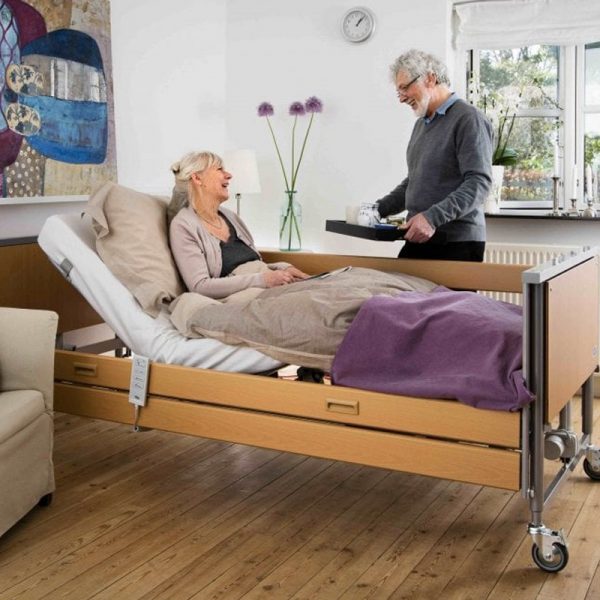Table of Contents
Introduction to Hospital Beds
Comparison of Manual and Electric Hospital Beds
Considerations for Patient Needs and Care
Safety Features of Manual and Electric Hospital Beds
Comfort and Convenience Aspects
Cost Comparison
Conclusion
FAQ
Comparison of Manual and Electric Hospital Beds
Hospital beds are categorized primarily into manual and electric beds. Understanding the differences between these types can help in making an informed choice.
Manual Hospital Beds:
- Operation: Operated by hand cranks.
- Adjustments: Suitable for basic positioning adjustments.
- Usage: Ideal for patients with minimal adjustment needs or in low-resource settings.
Electric Hospital Beds:
- Operation: Equipped with electric motors.
- Adjustments: Allow easy and multiple positioning adjustments with the push of a button.
- Usage: Best for patients requiring frequent repositioning or advanced care needs.
Considerations for Patient Needs and Care
When choosing between manual and electric hospital beds, it’s important to consider the patient’s specific needs and the type of care required.
Manual Beds:
- Mobility Impact: Limited adjustment options can affect patient mobility and independence.
- Caregiver Effort: Requires more physical effort from caregivers for adjustments.
- Best For: Patients who need basic care and do not require frequent repositioning.
Electric Beds:
- Flexibility: Offer flexible positioning, enhancing patient comfort and care.
- Independence: Allows patients to adjust their positions independently, promoting autonomy.
- Best For: Patients needing advanced care, frequent repositioning, or those with mobility issues.
Safety Features of Manual and Electric Hospital Beds
Safety is a paramount concern in patient care. Both manual and electric hospital beds come with safety features, but there are significant differences:
Manual Beds:
- Side Rails: Provide a safety barrier to prevent falls.
- Height Adjustment: Can be manually adjusted to a safer height for patient transfers.
- Emergency Situations: Adjustments during power outages are easier.
Electric Beds:
- Advanced Safety Features: Include side rails, bed exit alarms, and emergency stop functions.
- Accident Prevention: Automatically lock wheels and secure side rails.
- Ease of Use: Quick and easy adjustments enhance patient safety, especially in critical situations.
Comfort and Convenience Aspects
Comfort and convenience play a significant role in the recovery and well-being of patients.
Manual Beds:
- Comfort: Basic comfort benefits with limited adjustments.
- Ease of Use: Simple operation but requires physical effort for adjustments.
- Maintenance: Generally low maintenance with fewer electronic components.
Electric Beds:
- Enhanced Comfort: Multiple positioning options for better comfort.
- Convenience for Caregivers: Easier for caregivers to manage patient positioning and care.
- Additional Features: Often include features like massage functions, integrated scales, and more.
Cost Comparison
Cost is a critical factor when deciding between manual and electric hospital beds.
Manual Beds:
- Initial Investment: Generally lower upfront cost.
- Long-term Expenses: Potential for higher long-term costs due to maintenance and manual adjustments.
- Budget-Friendly: Suitable for low-budget settings.
Electric Beds:
- Upfront Costs: Higher initial investment.
- Potential Savings: Long-term savings due to reduced caregiver labor and advanced durability.
- Value for Money: Offers better value with advanced features and patient care benefits.
Conclusion
In summary, the comparison between manual and electric hospital beds highlights the importance of understanding the specific needs of patients, caregivers, and healthcare settings. Manual hospital beds offer basic functionality and are cost-effective, making them suitable for low-resource settings or patients with minimal adjustment needs. Electric hospital beds, on the other hand, provide advanced features, enhanced comfort, and better safety, making them ideal for patients requiring frequent repositioning and advanced care.
Making an informed decision about which hospital bed to choose is crucial for ensuring the best possible patient care and comfort. By considering the differences in safety, comfort, and cost, patients, caregivers, and healthcare professionals can select the most suitable hospital bed for their needs.
FAQ
Q: What are the main benefits of manual hospital beds?
A: Manual hospital beds are cost-effective, simple to use, and require no electricity, making them ideal for basic care and low-resource settings.
Q: How do electric hospital beds enhance patient care?
A: Electric hospital beds offer multiple adjustable positions, enhancing patient comfort, independence, and overall care. They are easy to operate and provide advanced safety features.
Q: Which type of hospital bed is more cost-effective in the long run?
A: While manual beds have lower upfront costs, electric beds may offer long-term savings due to their advanced features, reduced caregiver effort, and durability.
Q: Are electric hospital beds suitable for home care?
A: Yes, electric hospital beds are highly suitable for home care due to their ease of use, comfort, and advanced safety features, which enhance the overall care experience.
Explore our Manual and Electric Hospital Beds Collection to find the perfect bed for your needs and experience the best in patient care and comfort.


